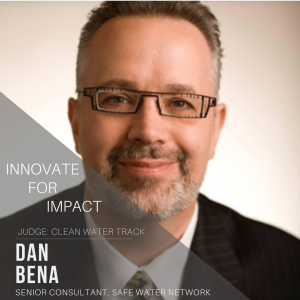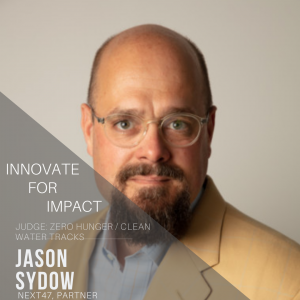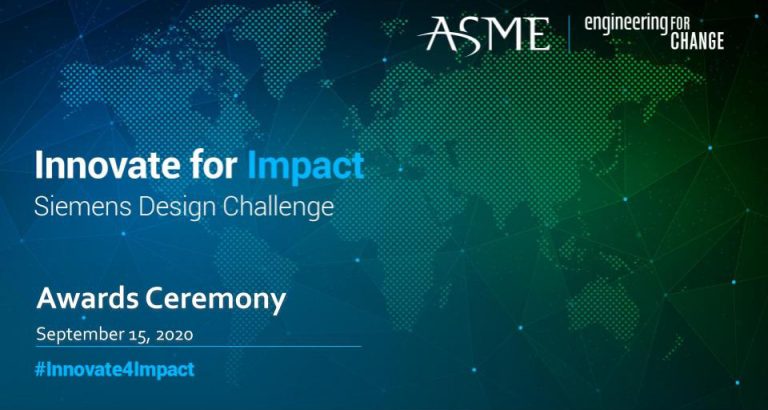See all of the judges and finalists in the Innovate for Impact: Siemens Design Challenge
Experts in their fields have undertaken the quiet work of combing through the hundreds of entries to the Innovate for Impact: Siemens Design Challenge to judge the most practical, creative and potentially viable solutions to vie for the prizes. These judges have risen to heights in their careers in industry, academia, non-profits and government. Some are engineers by training, others work in finance, distribution and other aspects of the development of a product from idea to marketplace.
The judges will soon announce their selections for the winners of the Design Challenge, one team from each of the two tracks: Clean Water and Zero Hunger. While waiting for their decisions, we wanted to glean some insight into their fields of expertise. We asked judges of the Siemens Design Challenge five questions, and offered them the chance to choose which to answer. These are their responses, updated as they reply.
 Dan Bena
Dan Bena
Dan Bena is a multi-award-winning executive who most recently served as Corporate Water Steward and led the Sustainable Development agenda for PepsiCo’s Global Operations. He founded his own passion-fueled consultancy, and serves as Senior Advisor to Safe Water Network. He has worked with the World Business Council for Sustainable Development, World Bank 2030 Water Resources Group, World Economic Forum Global Agenda Council on Water Security, and US Water Alliance, among other organizations.
E4C: What role do engineers and designers have in solving problems of food and water access in underserved communities?
DB: For too long, people in underserved communities were seen as “beneficiaries” of charity, and not legitimate consumers of goods and services. That’s changing, thankfully, and organizations are caring more about not only what people in these communities need, but also what they want. This will open up totally new markets, and engineers and product designers will have a nearly fresh palette on which to create technology, goods and services intentionally designed and fabricated for these new consumers, while helping to solve intractable global challenges along the way!
E4C: What prompted your interest in judging this competition, and has it worked out the way you had hoped?
DB: On a philosophical level, few things are more critical to me than helping to prepare the next generations of leaders, since they are facing unprecedented global challenges. If we can help in some small way, we must. More tactically, I have worked with Engineering for Change and with Siemens at different points in my career, and am so impressed with the quality of both organizations—the people, the capability, the discipline, and most important, the foundational values that drive them. They have set their own high bars of performance, and having been through the Challenge now as a judge, they did not disappoint!
E4C: What are you reading right now?
DB: Literally, within the last two weeks, the Vice-Chair of the Safe Water Network Board, Dr. Rita Colwell, published a book, called, “A Lab of One’s Own: One Woman’s Personal Journey Through Sexism in Science,” and I have just begun reading it. Dr. Colwell has truly achieved the heights in science, being passionate about her career in public health for over half a century. And to know that she accomplished what she did with so many obstacles in her path—solely because she is a woman—is awe-inspiring.
 Dr. Laura MacDonald
Dr. Laura MacDonald
Dr. Laura MacDonald is the Managing Director of the Mortenson Center in Global Engineering at the University of Colorado Boulder. Prior to joining the Mortenson Center, Dr. MacDonald was Knowledge and Research Advisor at the Centre for Affordable Water and Sanitation Technology (CAWST).
She holds degrees in Geography and Environmental Engineering from the Johns Hopkins University and Northwestern University, and her research has spanned topics from household water treatment and water-vending kiosks in Ghana, to capacity development of sanitation practitioners and the geochemistry of arsenic in the Atacama Desert.
E4C: What role do engineers and designers have in solving problems of food and water access in underserved communities?
LM: The engineering mindset and skillset are particularly well-suited to addressing the technical side of challenges to food and water access in underserved communities. At the same time, it’s important to recognize that many of the persisting challenges in these areas won’t be solved by designing a new technology or product and that, as engineers, we often aren’t equipped with the social, economic, political and public health knowledge and skills to address the underlying, systemic issues that are causing these problems. So, engineers are important contributors to a team approach that also draws on the expertise of these other disciplines to develop solutions that can be applied in different contexts. That’s why challenges like the Siemens Design Challenge are so important – to introduce engineers to the challenges that underserved communities are facing, to the constraints of working within these contexts, and to the barriers to solving problems that may otherwise seem straightforward if separated from the context.
E4C: What prompted your interest in judging this competition, and has it worked out the way you had hoped?
LM: It was important for me to contribute my time so that I could work with the other judges to evaluate the submissions not only based on their technical components but also on a given team’s consideration of the context and constraints. It was clear to me that many of the teams took the time to think critically and not just propose a textbook approach absent considerations of the context. Although I’m sure some great innovations will come from the challenge, I think, perhaps, the greater value in the long term will come from so many teams across the globe coming together to think about the challenges of food and water access in underserved communities. My hope is that this experience will support a new generation of engineers and product designers who realize that technology won’t solve all the world’s problems.
E4C: What are you reading right now?
LM: In my own time, I’m reading The Complete Persepolis, by Marjane Satrapi. I’ve only recently been introduced to the world of graphic novels, and I find it a really enjoyable way to learn from authors who are challenging the dominant narrative. Before this, the first graphic novel I read was Good Talk, by Mira Jacob, which I also highly recommend. Professionally, I’m reading The Global Engineers: Building a Safe and Equitable World Together, by Evan Thomas. In our roles at the Mortenson Center in Global Engineering, Evan and I recently took over the management of the University of Colorado Boulder’s Global Engineering First Year Academic Program, and this book will be a key tool for introducing global engineering to first-year undergraduate engineering students. In our class for these students, we’ll be encouraging them to consider – and even question at times – their role as engineers in global development, learning from the past while looking to the future of poverty reduction.
 Akshay Roongta
Akshay Roongta
Akshay Roongta is a design researcher and strategist who has worked in renewable energy, sanitation, maternal health and education, amongst other fields. He founded the consultation firm Ooloi Labs, and he previously started up Amrutdhara, a social enterprise focused on building IoT-based water ATMs to tackle the issue of access to safe drinking water in urban India.
More from Akshay | Human-Centered Design in Practice: People First, then People Again
E4C: What role do engineers and designers have in solving problems of food and water access in underserved communities?
AR: The key is that engineers and designers have a key role to play to facilitate community members and their ecosystems to find, implement and maintain solutions themselves. The ability to really engage with communities is something designers should be doing as their core activities, facilitating engineers coming in working with what is available as well as the ‘latest’ technology to help solve long standing as well as emerging problems.
E4C: What prompted your interest in judging this competition, and has it worked out the way you had hoped?
AR: Having been a social entreprenuer myself trying to work in the space of access to drinking water through systemic solutions, the opportunity to be involved in helping find and support other new ideas, innovations and teams is a fulfilling experience. It’s been even better than I had expected, partly because the quality of entries has been fantastic, and partly because I’ve gotten to learn so much from the other judges as well as the entrants about the state of affairs in domains such as food waste and desalination which are domains I haven’t engaged in directly in my work.
E4C: How would you characterize the solutions you judged? Any trends or ideas that jumped out as interesting?
AR: One major trend that I noticed was that there was a clear focus on working through a ‘sum is greater than the parts’ approach. The teams were focussed on using accessible components and materials but putting them together in new and ingenious ways to help solve the community’s problems. That’s not to say that all the solutions did this, but a fair few that made it to the penultimate round seemed to have this in common. For me this is really positive as it increases the chances that a solution will be maintained in the future, and have sustained usage.
E4C: What are you reading right now?
AR: I’m reading two books at the moment:
- Indica: A Deep Natural History of the Indian Subcontinent, by Pranay G. Lal
- The Flight of the Arconaut, by Sophia Khan
 Dr. Jason Sydow
Dr. Jason Sydow
Dr. Jason Sydow is a Partner with the investment team Next47 in Palo Alto, California. He focuses on application software, infrastructure software, additive manufacturing, and robotics. Prior to joining, Jason was a Partner with the venture capital firm QuestMark Partners, he served on the board of RF Code, and led licensing and new company formation for engineering and physical sciences in the tech transfer office of Arizona State University, among other positions.
Jason received his Ph.D. in Physics from Cornell University, an MPhil from the University of Strathclyde in the United Kingdom as a Marshall Scholar, and a B.S. from the University of Virginia.
In the limited free time that work and a family of six allows, Jason enjoys cycling, reading science fiction, and walking with the family Great Dane.
E4C: What role do engineers and designers have in solving problems of food and water access in underserved communities?
JS: The engineers I have worked with enjoy tackling the hardest challenges that can have the most positive impact for humanity. It is hard to think of work that is of more important or more challenging that providing food and water to underserved communities.
E4C: What prompted your interest in judging this competition, and has it worked out the way you had hoped?
JS: Siemens has a long history of expanding engineering solutions and innovations around the world, often for the first time in new parts of the world. Being able to take part in this great history, even in a small way, has been a rewarding part of my work at Next47 and Siemens.
E4C: What are you reading right now?
JS: A Deepness in the Sky, by Vernor Vinge
 Danielle Nierenberg
Danielle Nierenberg
Danielle Nierenberg is a renowned researcher, speaker, and advocate on issues relating to food systems and agriculture. She is Co-Founder and President of Food Tank, a 501(c)(3) nonprofit organization focused on building a global community for safe, healthy, nourished eaters. Danielle has an M.S. in Agriculture, Food, and Environment from the Tufts University Friedman School of Nutrition Science and Policy.
E4C: What are you reading right now?
DN: I’m reading Perilous Bounty by Tom Philpott and re-reading Diet for a Small Planet by Frances Moore Lappe.
 Bob Rabatsky
Bob Rabatsky
Bob Rabatsky is a specialist in agribusiness, project design, management, and evaluation, who has more than 30 years of experience managing complex USAID and multilateral development bank projects in Africa, Asia, Eastern Europe and Latin America.
Read more | Where to Start: Design Agtech Solutions to Scale
E4C: What role do engineers and designers have in solving problems of food and water access in underserved communities?
BR: Much of food production, processing and marketing has scaled up significantly in the past century resulting in dramatically increased yields and efficiency, which means more food, higher-quality food, and lower-cost food for consumers. This transformation is mainly due to investment in technology, both mechanical and biological, which is the playground of engineers. The problem facing underserved communities (emerging markets) is one of distribution and applicability. These markets don’t have access to the technologies that are common in developed economies, and if they did, the scale and applicability are not aligned to what emerging markets need. A good example is production equipment, large tractors, seeders, harvesters, etc which don’t match the scale of farming practices. Electricity is scarce and unreliable and roads networks poorly developed, so technologies for food production and marketing must be adapted to fit these contexts. Addressing these issues is the important role that engineers and designers must play.
E4C: What prompted your interest in judging this competition, and has it worked out the way you had hoped?
BR: My entire career has focused on improving the productivity and competitiveness of agriculture in emerging markets. Much of the world’s population growth is taking place in these economies, and therefore food availability, quality and diversity must dramatically increase, and access (cost) must decrease in order to support this growth. Ag technology is integral to meeting these goals, and supporting innovators and entrepreneurs in this space give me great joy, quite frankly. The Siemen’s competition creates an incentive to help bring these ideas into the marketplace. We’ll have to wait and see whether the winners will succeed, but seeing the technologies that people are working on is encouraging.
E4C: How would you characterize the solutions you judged? Any trends or ideas that jumped out as interesting?
BR: As I mentioned above, what is exciting is to see how the applicants are developing technologies that are designed to meet the needs of users in these markets. Understanding the market and developing solutions to address pain points in the farm-to-market supply chain helps to position a given solution so that it has the best opportunity to succeed in the market. Trends worth noting are solutions that leap-frog the availability of energy, such as solar, hydro or bio power sources that reduce the dependency on electric grids that may be years or decades away for many agrarian communities. Mobile communication technologies that allow for sharing data or facilitate distribution networks is another area of importance.
E4C: What is the future of tchnologies for desalination or post-harvest loss reduction in underserved communities?
BR: I see food production and post-harvest handling moving closer to urban centers where demand is focused. Africa will see a dramatic population shift to cities, and collection, storage, processing and distribution technologies and businesses need to take this into account. These populations will demand more animal protein in their diet, more convenience in food preparation, and they will dine out more often. Innovations that improve cold chains, preserve foods either by processing or freezing, and, most importantly, streamline distribution systems will be in high demand.
E4C: What are you reading right now?
BR: I have been reading Yuval Noah Harari’s Sapiens and Homo Deus. Sapiens was a dive into the brief history of mankind and how we developed into the world’s dominant species. We’ve mastered the game; for example, more people die today from overeating than from famine, or die from old age than from disease. Homo Deus is a “brief history of tomorrow,” which discusses how, by making this progress, mankind may in fact have become its own worst enemy unless we can figure out how to manage our development more carefully. Thought provoking for sure.
 Christian Homma
Christian Homma
Dr. Christian Homma is Senior Innovation Manager at Siemens Corporate Technology, responsible for the Siemens Innovation Ecosystem platform, Open Innovation, the Siemens corporate crowdfunding program Quickstarter and coordinating the 100m EUR Siemens Innovation Fund. Prior to that he was leading the technology and trend scouting activities at CT, while also having 12 years background in research and development. He holds a masters degree in physics from the Technical University Munich and a PhD in material sciences from University of Saarbrücken, and is a certified coach and Scrum master and product owner.
E4C: What prompted your interest in judging this competition, and has it worked out the way you had hoped?
CH: Sustainability is one of my personal concerns and I felt honored to be part of the judges panel. The solutions impressed me and strengthened my confidence that we are on the right track to create a more sustainable way of life.
E4C: What is the future of tchnologies for desalination or post-harvest loss reduction in underserved communities?
CH: No community and especially underserved ones can afford to produce waste. Therefore we will see more community-based self-sustainable solutions using circular economy, e.g. maggot farms next to fields using spoiled crops.
E4C: What are you reading right now?
CH: Our Iceberg Is Melting, by John Kotter.

